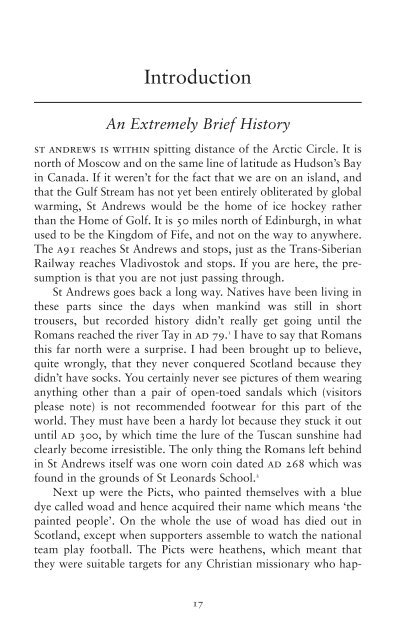Pilgrims in the Rough by Michael Tobert sampler
For centuries, people have been travelling to St. Andrews. Whether they were on a holy pilgrimage to see the magnificent Cathedral and the preserved bones of St. Andrew, or devout golfers putting their skills to the test on the Old Course - that holy grail of golf courses - or just students and scholars jostling for a place at one of Scotland’s most esteemed centres of learning, St. Andrews has always attracted pilgrims. Michael Tobert leads his readers through St. Andrews’ historic highs and lows with a potent combination of the anecdotal and the informative. His writing is both astute and downright funny, and he proves that sometimes, truth really is stranger than fiction.
For centuries, people have been travelling to St. Andrews. Whether they were on a holy pilgrimage to see the magnificent Cathedral and the preserved bones of St. Andrew, or devout golfers putting their skills to the test on the Old Course - that holy grail of golf courses - or just students and scholars jostling for a place at one of Scotland’s most esteemed centres of learning, St. Andrews has always attracted pilgrims.
Michael Tobert leads his readers through St. Andrews’ historic highs and lows with a potent combination of the anecdotal and the informative. His writing is both astute and downright funny, and he proves that sometimes, truth really is stranger than fiction.
Create successful ePaper yourself
Turn your PDF publications into a flip-book with our unique Google optimized e-Paper software.
Introduction<br />
An Extremely Brief History<br />
st andrews is with<strong>in</strong> spitt<strong>in</strong>g distance of <strong>the</strong> Arctic Circle. It is<br />
north of Moscow and on <strong>the</strong> same l<strong>in</strong>e of latitude as Hudson’s Bay<br />
<strong>in</strong> Canada. If it weren’t for <strong>the</strong> fact that we are on an island, and<br />
that <strong>the</strong> Gulf Stream has not yet been entirely obliterated <strong>by</strong> global<br />
warm<strong>in</strong>g, St Andrews would be <strong>the</strong> home of ice hockey ra<strong>the</strong>r<br />
than <strong>the</strong> Home of Golf. It is 50 miles north of Ed<strong>in</strong>burgh, <strong>in</strong> what<br />
used to be <strong>the</strong> K<strong>in</strong>gdom of Fife, and not on <strong>the</strong> way to anywhere.<br />
The a91 reaches St Andrews and stops, just as <strong>the</strong> Trans-Siberian<br />
Railway reaches Vladivostok and stops. If you are here, <strong>the</strong> presumption<br />
is that you are not just pass<strong>in</strong>g through.<br />
St Andrews goes back a long way. Natives have been liv<strong>in</strong>g <strong>in</strong><br />
<strong>the</strong>se parts s<strong>in</strong>ce <strong>the</strong> days when mank<strong>in</strong>d was still <strong>in</strong> short<br />
trousers, but recorded history didn’t really get go<strong>in</strong>g until <strong>the</strong><br />
Romans reached <strong>the</strong> river Tay <strong>in</strong> ad 79. 1 I have to say that Romans<br />
this far north were a surprise. I had been brought up to believe,<br />
quite wrongly, that <strong>the</strong>y never conquered Scotland because <strong>the</strong>y<br />
didn’t have socks. You certa<strong>in</strong>ly never see pictures of <strong>the</strong>m wear<strong>in</strong>g<br />
anyth<strong>in</strong>g o<strong>the</strong>r than a pair of open-toed sandals which (visitors<br />
please note) is not recommended footwear for this part of <strong>the</strong><br />
world. They must have been a hardy lot because <strong>the</strong>y stuck it out<br />
until ad 300, <strong>by</strong> which time <strong>the</strong> lure of <strong>the</strong> Tuscan sunsh<strong>in</strong>e had<br />
clearly become irresistible. The only th<strong>in</strong>g <strong>the</strong> Romans left beh<strong>in</strong>d<br />
<strong>in</strong> St Andrews itself was one worn co<strong>in</strong> dated ad 268 which was<br />
found <strong>in</strong> <strong>the</strong> grounds of St Leonards School. 2<br />
Next up were <strong>the</strong> Picts, who pa<strong>in</strong>ted <strong>the</strong>mselves with a blue<br />
dye called woad and hence acquired <strong>the</strong>ir name which means ‘<strong>the</strong><br />
pa<strong>in</strong>ted people’. On <strong>the</strong> whole <strong>the</strong> use of woad has died out <strong>in</strong><br />
Scotland, except when supporters assemble to watch <strong>the</strong> national<br />
team play football. The Picts were hea<strong>the</strong>ns, which meant that<br />
<strong>the</strong>y were suitable targets for any Christian missionary who hap-<br />
17


















